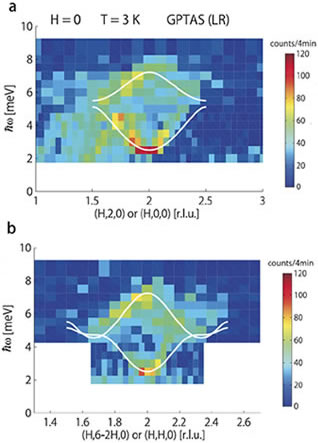Condensed Matter Experiment Ⅱ
Quantum Spin Physics
http://www2.tagen.tohoku.ac.jp/lab/sato_tj/
Staff
| Professor : | Taku J Sato | |||
| Associate Professor : | Kazuhiro Nawa | |||
| Assistant Professor : | Katsuki Kinjo | |||
Research
Generally, thermal fluctuations are suppressed at low temperatures, and therefore, any degrees of freedom tend to freeze there. Nevertheless, due to their very large quantum fluctuations, electron spins sometimes show quite intriguing and largely fluctuating ground states at low temperatures. Such fluctuating ground states may be enhanced by geometrical frustration, low dimensionality, and/or coupling to other degrees of freedom. We are aiming at understanding such fluctuation-dominated ground states, and also at finding novel macroscopic quantum phenomena due to the quantum fluctua- tions, using neutron inelastic scattering.
Neutron inelastic scattering provides spin- dynamics information in the energy range of roughly 0.01 to 1000 meV, which is indeed an important range for solid state physics. In particular, using the state-of-art spectrome- ters developed at the new spallation neutron source J-PARC, we can simultaneously mea- sure the scattering function in a wide Q and ̄hω range, which gives whole feature of spin dynamics quite easily.
This group, using neutron scattering, works on the following issues:
- Antiferromagnetism and supercon- ductivity in itinerant electron antifer- romagnets
- Macroscopic quantum phenomena in low-dimensional and/or geometrically frustrated quantum spin systems
- Order and dynamics in aperiodic spin systems
- Development of novel neutron inelas- tic spectroscopy
- Development of analysis method for neutron inelastic scattering
As above, we work both on the solid state phycis and technical development. While using many neutron facilities in the world to conduct neutron experiments, we are also involved in the spectrometer development projects both at the JRR-3 research reactor and J-PARC/MLF. This is quite unique style, worth devoting our time.

As a recent example, we show in the figure the inelastic scattering spectra observed in the deformed quantum kagome antiferromag- net Rb2Cu3SnF12. This material was known to show non-magnetic ground state at low temperatures, but the wave-function realiz- ing the non-magnetic ground state was totally unknown. By measuring spin excitation from the ground to the triplet-excited states, we have shown that the ground state consists of singlet dimers arranged in the pinwheel pat- tern, which is now called pinwheel Valence- Bond-Solid state. This will give an important clue to understand physics of Resonating- Valence-Bond state, which is long sought in the ideal quantum kagome antiferromagnet.

